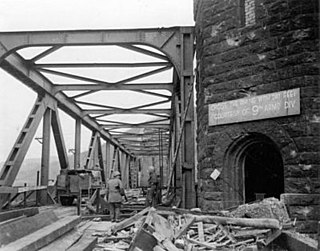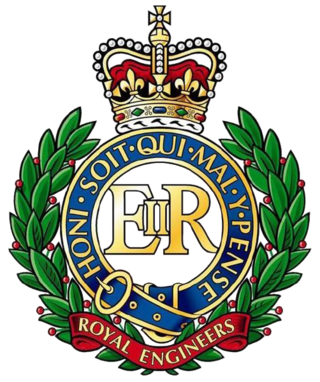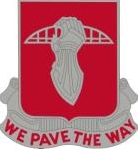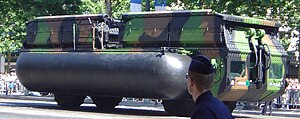
A military engineering vehicle is a vehicle built for construction work or for the transportation of combat engineers on the battlefield. These vehicles may be modified civilian equipment or purpose-built military vehicles. The first appearance of such vehicles coincided with the appearance of the first tanks, these vehicles were modified Mark V tanks for bridging and mine clearance. Modern military engineering vehicles are expected to fulfill numerous roles such as; bulldozer, crane, grader, excavator, dump truck, breaching vehicle, bridging vehicle, military ferry, amphibious crossing vehicle, and combat engineer section carrier.

A pontoon bridge, also known as a floating bridge, uses floats or shallow-draft boats to support a continuous deck for pedestrian and vehicle travel. The buoyancy of the supports limits the maximum load that they can carry.

The Panhard ERC is a French six-wheeled armoured car which is highly mobile and amphibious with an option of being NBC-proof. While various models were tested, only two versions of the ERC entered production in large numbers: the ERC-90 Lynx and the ERC-90 Sagaie. The main difference between the two versions is the type of turret and 90 mm gun fitted. Sagaie is French for assegai, a type of African spear.

The Foudre-class landing platform dock is a class of landing platform docks designed and constructed for the French Navy. Designated Transport de Chalands de Débarquement, they were intended to replace the ageing Ouragan class and the construction of four vessels was planned. Only two were built and the remaining two were instead reordered as Mistral-class amphibious assault ships. The two ships of the Foudre class, Foudre and Siroco, operated with the French Navy between 1990 and 2014. Replaced by the Mistrals, in 2011 Foudre was sold to the Chilean Navy and Siroco was sold to the Brazilian Navy in 2015.

An armoured vehicle-launched bridge (AVLB) is a combat support vehicle, sometimes regarded as a subtype of military engineering vehicle, designed to assist militaries in rapidly deploying tanks and other armoured fighting vehicles across gap-type obstacles, such as rivers. The AVLB is usually a tracked vehicle converted from a tank chassis to carry a folding metal bridge instead of weapons. The AVLB's job is to allow armoured or infantry units to cross craters, anti-tank ditches, blown bridges, railroad cuts, canals, rivers and ravines, when a river too deep for vehicles to wade through is reached, and no bridge is conveniently located, or sufficiently sturdy, a substantial concern when moving 60-ton tanks.

The Battle of Remagen was an 18-day battle during the Allied invasion of Germany in World War II. It lasted from 7 to 25 March 1945 when American forces unexpectedly captured the Ludendorff Bridge over the Rhine intact. They were able to hold it against German opposition and build additional temporary crossings. The presence of a bridgehead across the Rhine advanced by three weeks the Western Allies' planned crossing of the Rhine into the German interior.

The Kent Fortress Royal Engineers (KFRE) was a volunteer Territorial unit of the British Army that saw service in both World Wars. They are notable for their successful actions in May 1940, when they destroyed substantial oil stocks and installations just ahead of the German advance, and in August 1944 during the assault crossing of the River Seine.

The M3 Amphibious Rig is a self-propelled, amphibious bridging vehicle and ferrying vehicle that is used for the projection of tanks and other vehicles across water obstacles.

The Engin de débarquement amphibie rapide (EDA-R) is a class of French roll-on/roll-off catamaran landing craft (L-CAT) operated by the French and Egyptian navies. They transport vehicles, cargo and personnel from Mistral-class amphibious assault ships to shore.

The Siebel ferry (Siebelfähre) was a shallow-draft catamaran landing craft operated by Germany's Wehrmacht during World War II. It served a variety of roles in the Mediterranean, Baltic and Black Seas as well as along the English Channel. They were originally developed for Operation Sea Lion in 1940, the cancelled German invasion of England. Siebel ferries continued performing after the war's end in 1945.

This is a list of bridging and trackway equipment used by the Royal Engineers of the British Army. For more equipment in use with the Royal Engineers, see Modern equipment of the British Army.

The 17th Armored Engineer Battalion was a part of the 2nd Armored Division "Hell on Wheels". During World War II, they were active in North African Campaign, and Western Europe Campaign. 17th Armored Engineer Battalion was founded on 1 October 1933 as part of the US Army. First called 17th Engineer Battalion, Motorized. It was renamed on 10 July 1940 to 17th Engineer Battalion (Armored) and assigned to the 2nd Armored Division. The unit became active and started training 15 July 1940 at Fort Benning, Georgia. Renamed again on 8 January 1942 as the 17th Armored Engineer Battalion. The Battalion is now based at Fort Cavazos, Texas. The battalion's motto was We pave the way. Tasks of the 17 included construction and demolition under combat conditions, constructing and breaching trenches, tank traps and other fortifications, bunker construction, bridge and road construction, and building destruction bridges and other physical work in the battlefield whenever needed. They also laid and cleared land mines. The 17th facilitated the movement and support of friendly forces while slowing down the enemy's forces.

The 289th Engineer Combat Battalion was a combat engineer battalion of the United States Army during World War II. It served under XXI Corps of the Seventh Army in action mainly in France and Germany in 1944 and 1945. It received campaign credit for participation in the Ardennes-Alsace campaign , Rhineland campaign, and the Invasion of Germany.

The 549th Engineers Light Pontoon Company was a combat engineer company of the United States Army during World War II. Operationally attached to the 1150th Engineer Combat Group, it served under XXI Corps of the Seventh Army in action in France and Germany in 1944 and 1945.

An Engineer Light Ponton Company was a combat engineer company of the United States Army that served with U.S. Army ground forces during World War II. It was primarily a highly mobile pontoon bridge construction unit, though it also provided both M2 assault boats and a selection of infantry support bridging, ferries, and rafts.

The Folding Boat Equipment, abbreviated as FBE, is a light pontoon bridging equipment which was in use by the British and its colonial armies during the 20th century. The equipment was introduced in 1928 and was the standard light bridge used for loads up to class 5, i.e. providing rafts or a bridge capable of transporting loads up to 5 tons of weight. The initial version was followed by a Mk II but without change of capacity. In 1938 the Mk III version of the bridge was introduced with significant changes and an increase of load capacity to 9 tons, i.e. load class 9.

The 1139th Engineer Combat Group was a technical United States Army Headquarters Unit providing administration and supervision support to Combat Engineers on bridge building and other construction activities during World War II. The 1139th Engineer Combat Group was part of the Third Army and was attached for operations to the XX Corps in direct support of the 7th Armored Division. The 1139th Engineer Combat Group fought from northern France to Austria in World War II, supporting General George Patton's Third Army's rapid movements during the war.

British logistics supported the operations of Field Marshal Sir Bernard Montgomery's Anglo-Canadian 21st Army Group in the Western Allied invasion of Germany from 8 January 1945 until the end of the Second World War in Europe on 8 May 1945. To conserve scarce manpower, the British and Canadian forces employed mechanisation and materiel for maximum effect in combat operations. This involved prodigious use of ammunition, fuel, and equipment, which in turn demanded a first-class military logistics system. By this time, the British Army was highly experienced, professional, and proficient.
Bridges have been a strategic and tactical aspect of the Russo-Ukrainian War, particularly since the 2022 Russian invasion of Ukraine. As there are more than 23,000 rivers and over 28,000 bridges in Ukraine, several important events, including battles, blocked advances, political disputes, and the successes and failures of army units, have centered around the country’s bridges. The UK Ministry of Defense has said, "River crossing operations are likely to be amongst the most important determining factors in the course of the war".



















